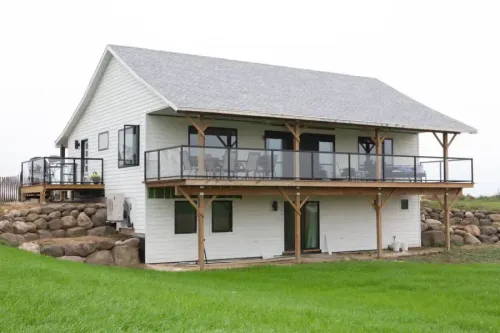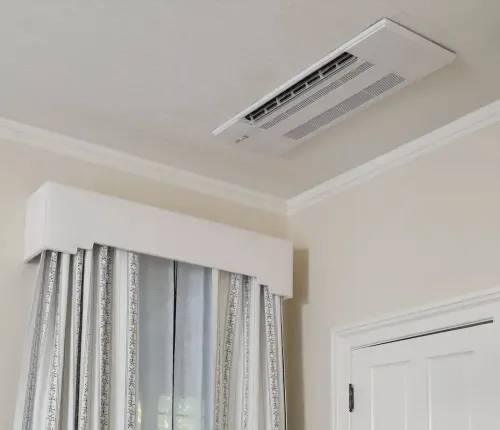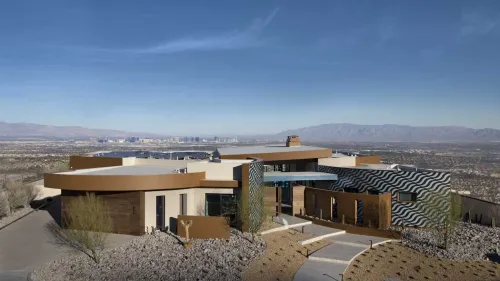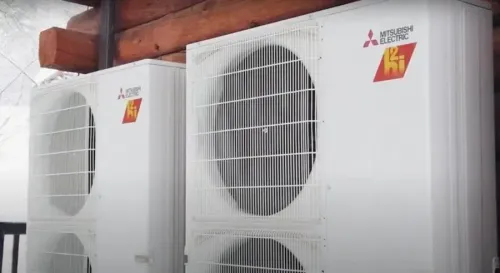Project Location: Columbus, Ohio
Completion Date: October 2019
Challenge
Specifying a versatile, cost-effective and energy-efficient HVAC system for a mixed-use buildingSolution
CITY MULTI® Variable Refrigerant FlowResult
An energy-efficient building that maximizes leasable space and keeps occupants comfortable while minimizing operational costs
Since its opening in fall 2019, the 800 North High Street Building has become a fixture in the community. Part of Columbus, Ohio’s Short North Arts District, a neighborhood known for promoting local businesses and culture, this modern, mixed-use development features a coworking space, two restaurants and Marriott’s new, modern hotel brand, Moxy. “When you look at the Short North, you’re talking about the hottest submarket within the hottest city in the Midwest,” said Nelson Yoder, Ra, principal at Crawford Hoying Development (Crawford Hoying).
In securing a piece of sought-after, premium real estate, Crawford Hoying had to ensure the building would drive revenue and that its mechanical systems could help balance costs through efficiency and design flexibility. After positive past experiences using CITY MULTI® Variable Refrigerant Flow (VRF) systems from Mitsubishi Electric Trane HVAC US (METUS), the firm’s optimal choice for 800 North High Street was clear.
“When we approach a building like this, we’re constantly evaluating it on a bunch of different viewpoints. Energy efficiency is an important pillar along with aesthetics, occupant comfort and how the uses come together,” explained Yoder. “As we were looking at systems that could satisfy all those demands, VRF really came to the fore. And Mitsubishi Electric’s VRF system is one we’ve had great experience with.”
Design Flexibility For Any Aesthetic
For the 10-story, 150,000-square-foot building, the engineers at Pe Services specified 215 tons of Mitsubishi Electric VRF equipment. “One of the main benefits of this VRF system is that there are a number of unit types that can all be packaged for the infrastructure of the project,” said Craig Slaughterbeck, president, Pe Services. “This is space saving and helped us meet the needs of the architecture firm as we had to spatially allocate the HVAC system to fit within their desired aesthetic.”
Aesthetics were a key concern for the building, especially for the hotel portion. “For this project, we have 250 indoor units and the styles vary based on their location throughout the building,” said Bryan Crnarich, Pe, commercial regional manager, METUS. “In the hospitality areas of the building, it was really important to the ownership that we had ducted style units. In the electrical areas, we have wall-mounted units and in the co-working space we have sleek, ductless ceiling cassettes.” To meet Moxy’s brand standards as well as the local zoning authority’s criteria, Crawford Hoying had to keep a simple, clean look for the rooms. That criteria even applied to the mechanical systems. “Many hotels have the grill underneath the window associated with aPackaged Terminal Air Conditioner (Ptac) unit. At this site, we have fantastic skyline views so the last thing we wanted to do was obscure them with a mechanical system,” explained Yoder. “Besides our own aesthetic tastes, we couldn’t obtain zoning approval with a Ptac unit. Some agencies do not like this look. By going with Mitsubishi Electric VRF we were able to eliminate that as a concern. Besides, letting the mechanical system ‘disappear’ into a room is fantastic for creating an overall ambience.”
Maximizing Leasable Space
VRF’s design flexibility also helped create more usable, leasable and revenue-generating space for the building. The contractors at G Mechanical Inc. installed 90 percent of the mechanical systems for the building on a single platform located on the roof. “The Mitsubishi Electric outdoor units are allowed to sit so close together (while still running efficiently). Everything was so compact, the platform even includes the Mitsubishi Electric DOAS unit,” said Sean Minshall, project manager, G Mechanical. With such space-saving benefits, the architects were able to add a rooftop bar to the same level as the mechanical platform.
Crawford Hoying also appreciated Mitsubishi Electric’s compact, two-pipe system when designing the interior of the building. “By selecting a VRF system, we could reduce penetrations from giant duct openings to much smaller chases for the line-sets. This allowed us to save on both shaft construction, shaft wall construction on the front end as well as realize some more income from leasable space throughout the lifecycle of the building,” said Yoder. “If you were to compare that with a unitary system, we’d have very large duct runs going down the corridor and coordination would have been a lot more difficult,” added C.J. Giannetto, owner, G Mechanical.
All-Season Comfort
As for the day-to-day operations of the building, comfort management is critical, especially with the frigid winter temperatures in Columbus. Fortunately, Mitsubishi Electric’s HyperHeating INVERTER® (H2i®) technology keeps the building warm and running efficiently, even in the coldest of winter weather. “For this particular design, we specified 21 outdoor hyper-heat, heat-recovery units. In an area like Columbus, Ohio, we have winter design temperatures near zero degrees,” said Crnarich. “That said, at this site, we do not have supplemental heat, nor do we have concern with auxiliary heat as the outdoor units are able to maintain the set point temperature even on a zero-degree day.”
The system’s heat recovery also helps provide a comfortable atmosphere while ensuring efficient energy usage. “Heat recovery operation is ideal in a building like this. The system uses itself to reject heat one way or the other without rejecting it outside which would normally be way more costly,” explained Minshall.

Cost Savings From The Start
First costs and operational expenses were top of mind for Crawford Hoying. “In a case like this, where we have a site that is very expensive and construction costs are constantly going up, we’re looking for every advantage we can possibly get,” said Yoder.
With VRF technology’s unique ability to add indoor units as spaces are leased, the Mitsubishi Electric team ensured a cost-effective installation by allowing Crawford Hoying to defer some of the tenant improvement (Ti) fit-out costs to a later date. “We noticed more options for savings by going with Mitsubishi Electric VRF. As we built shell office space, we were able to set up the infrastructure in a ‘plug and play’ method where we wouldn’t have to invest in 100 percent up front,” said Yoder.
Another cost advantage of choosing CITY MULTI VRF? Rebate eligibility. “Because of the superior energy efficiency of VRF systems, METUS was able to help seek out utility rebates for this site on behalf of Crawford Hoying,” explained Crnarich. “Currently, we have pending rebates through the local utility provider. These rebates are based upon equipment improved efficiencies over ASHRAE’s baseline figures. For every kilowatt hour improved, this could save the owner up to 10-cent credit per kilowatt hour.”
Yoder added, “This helped make the system a little more affordable, so we were able to realize the long-term savings that came with the system without having to pay quite as much on the front end.”
With the building now complete and the space leased out, the ownership has received nothing but high praise on both the design of the building and the atmosphere. With Mitsubishi Electric’s Diamond Controls™ solutions, the facilities team is easily able to manage all spaces within the building, in-person or remotely. “Diamond Controls gives you access to a lot of different information,” said Minshall. “It will let you know how the systems are running, zone temperatures and it will send error messages as needed. Especially for the hotel portion of the building, this platform is important as you can reset systems without interfering with the guests.”
The system’s precise management, energy efficiency, cost effectiveness and small footprint have made quite the impression on Crawford Hoying. “With the modular nature of the VRF system, if one of the modules happens to need service, we still have the vast majority of our units up and running,” said Yoder. “It gives us that strategic advantage over some of our other competitors.”
Project Team
- Developer: Crawford Hoying Development, Dublin, Ohio
- Property Management: Shaner Hotel Management, State College, Pennsylvania
- Engineer: Pe Services, Lebanon, Ohio
- Mechanical Contractor: G Mechanical Inc., Columbus, Ohio
- Architect: Moody Nolan, Columbus, Ohio
Equipment Installed
- (20) PMFY One-Way Ceiling Cassettes
- (26) PLFY Four-Way Ceiling Cassettes
- (166) PEFY Ceiling-Concealed Ducted Indoor Units
- (10) PCFY Ceiling-Suspended Indoor Units
- (20) PURY R2-Series H2i Outdoor Units
- (1) PUHY Y-Series Outdoor Unit
- (6) PVFY Multi-Position Air Handlers
- (25) PKFY Wall-Mounted Outdoor Units
- (243) Simple MA Controllers
- (1) Ae-200A Centralized Controller
- (6) Ew-50A System Remote Controllers









